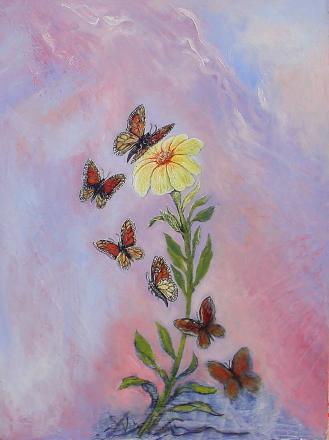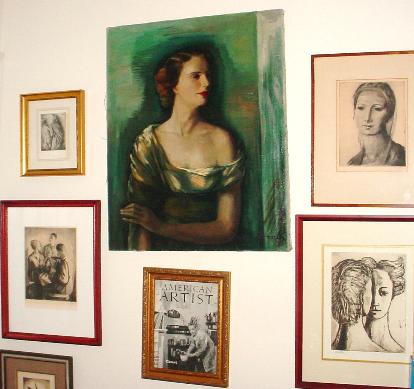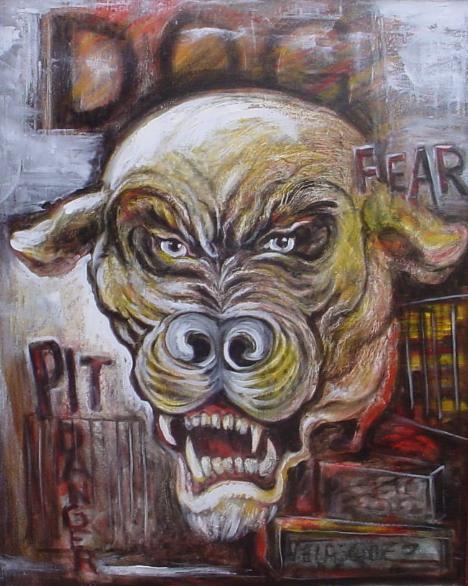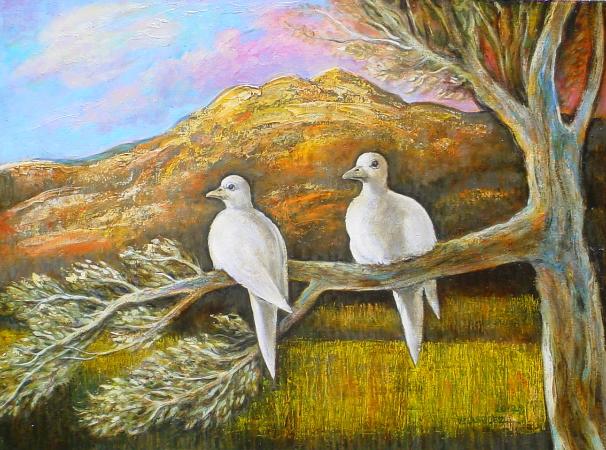THE PAINTINGS ON THIS SIDE ARE NOT FOR SALE In time I will display more paintings. I get so busy I have to prioritize. Eventually I will post some older paintings from the 1960's. These will be at higher prices as they are scarce and limited. And, others are from the beginning of my CSO research since 2000. These vary in price. Now that I am finished [ 2012] with research and writing and producing DVDS, I will be painting more. These will be offered at lower prices. A normal painting takes me about a week or two to complete. Some take longer. Please note this about the selling of paintings. When an artist CONSIGNS his paintings to a COMMERCIAL ART GALLERY, he agrees to a contract calling for the Artist to receive only about 50% of the agreed CONTRACT RETAIL PRICE. The prices I list here take this into account. My price of $500 for a painting is equivalent to a retail sale price by a gallery for $1000. Also, I will pay for shipping and any California State taxes. A low cost frame is included and will not be removed - and the price will not be lowered by being asked to remove the frame. Purchasers can always purchase a more expensive frame locally. My frames also MAY have very minor dents, etc, and these in no way change the price. Frames protect the painting and Master paintings in Museums are seen to have frames with minor dents etc. BEFORE purchasing a painting please ask all the questions that come to mind.--Thank you---Louis |
| I learned to oil paint by studying books by Mr. Frederic Taubes ( 1900-1981), the noted American artist and educator. Mr. Taubes believed the 15th century Flemish Old Masters, known for some of the best preserved oil paintings, used Copal Resin, as an ingredient in their painting medium. In the 1940's Mr. Taubes' experiments and studies, led him to formulate a line of paint mediums that became famous, and were sold under his name, "Taubes". I learned to oil paint using his mediums. Subsequent developments in technology resulted in wide use of Acrylic paints, and development of Synthetic resins, including synthetic Copals. After Mr. Taubes' death, his paint mediums declined and disappeared from the market. During Taubes' life, there were notable 'experts' who disagreed with Mr. Taubes' beliefs.They claimed use of hard natural resins, like Copal or Amber, were in fact injurious to the long term preservation of oil paint. They claimed eventual darkening and brittleness of the oil paint layers. After Mr. Taubes' death, the scientific analytic methods of paint samples from Old Master paintings improved, providing information Mr. Taubes was unaware of. Since the 1990's, advanced studies show the addition of calcium carbonate in the colors of some masters ( it was known to be used in the white) and the addition of protein ingredients such as egg, in the paint structure. Professor DR. Ernst Van De Wetering, a renowned Rembrandt scholar has stated the protein ingredient has been found in the work of Rembrandt AND Jan Van Eyck. My book will show how to easily make and apply two different Emulsions, each having important different properties. The Emulsion has several uses. One purpose is to use the Emulsion as an 'Oil out' to insure adhesion. Another purpose is to stop wrinkling in polymerized impasto paint. A very important purpose of the Emulsion is to use it as the ideal paint thinner, to change the paint consistency and to allow the painting of micro-fine lines and details. My experiments with "Calcite Sun Oil" and "Emulsions" have resulted in a SAFE and PERMANENT method of oil painting that has solved all the technical problems I encountered for many years using hazardous solvents, resins, and driers. The benefits of using "Calcite Sun Oil" and Emulsions are many, and my book will provide you with knowledge to help you master the oil painting medium with excellent results. |
| 'Butterflys' ( Mariposas) Oil on Birch plywood, 2006, 24" X 18", 2006, with details. The actual size of the butterflys is about two inches. The micro-fine white lines were painted on top of a wet black paint. My book will show you how to do this. Each white line or dot is raised, firm, clear, without any bleeding or distortion. And, they dry within 24 hours. |


| LA PALOMA TRISTE ( THE SAD DOVE) Oil on Birch plywood, 24" X 18", 2006, with detail. "Calcite Sun Oil" as the Grinding Oil creates a viscous paint, and the Emulsion is used as the thinner and the 'oil out'. Together they allow the artist to create abstracted forms or fine detailed realistic forms. Addition of dry calcite allows thick impasto when desired. |


| "SHORTY" Oil on Birch plywood, 30 X 24" , 2006, with detail. This painting evolved through five overpaint sessions. Each time, a Viscous Emulsion was used as the 'oil out' to insure adhesion of the new paint layer. And, to allow firm clear thick and thin paint that stayed exactly as I placed it. Blending was easily done when needed. |


| "La Paloma y La Tormenta" ( The Dove and the Storm) 1/2 Inch Wood Birch plywood, 18" X 24" CSO Oil Paint medium and Emulsions PRICE $1500 CONTACT velapress@aol.com |

EMULSIONS, the " WONDER MEDIUM " The effects you see in my recent paintings using my formulations of "Calcite Sun Oil" ,and Emulsions are easily accomplished. The ingredients are SAFE and have been proven to be PERMANENT as famous masterpieces of history show. EGG is one of the oldest binders ever used for painting, and experts have stated it is more durable than oil as a binder. The main limitation of the EGG TEMPERA PAINTING METHOD, where egg is the binder, is that it dries so fast, and blending is made very difficult even in the hands of highly skilled masters. One method of blending is by hatching and cross-hatching fine lines. Andrew Wyeth, a famous American artist is a master of EGG tempera painting and the famous Van Eyck brothers from 15th century northern Europe were trained as EGG tempera paintings. It is the Van Eyck brothers who formulated a revolutionary new paint medium ( kept as a secret) that allowed them to overcome all the deficiencies of the ancient oil paint medium. The oil in the ancient oil paint medium had either one of two properties: viscosity or non-viscosity, and each had great advantages and disastrous disadvantages. Read my book for a full explanation of these two conditions of the oil, and why they caused artists so many problems. |
| TRIANGULARISM A STYLE I DEVELOPED, BASED ON THE PAINTINGS OF ' EL GRECO' El Greco , Domenico Theotokopolous, has always been one of my favorite painters. He lived in an era surrounded by the art history of Greece, Rome, the classical Italian Renaissance art of Da Vinci, Michelangelo, Raphael and others and actually studied with Titian. He left Italy to live in Toledo Spain, where he died in 1614. When I was 10 years old, I saw my first E Greco painting in a book. His paintings IMMEDIATELY and POWERFULLY appealed to me because of his masterful control of the Oil Paint; his very personal vibrant, rich, deep color combinations; his extraordinarily personal dynamic design composition structure; and his unique realism, using aspects of surrealism... much of the masterful aspects of his work, were far ahead of his time, while his form of 'realism' was still accepted in his own time. Velazquez, born in Seville Spain in 1599, loved his work! Francisco Pacheco, Velazquez' teacher, wrote about actually watching El Greco paint! Over the years I was so captivated by and drawn to El Greco's elongated forms, and the other aspects of his work I described that I sought out every original I could find. Ive traveled Spain, Europe and American museums... JUST to see the El Grecos ( and also to see every one of Rembrandt's work I could find). I the year 2006, I was painting the painting " SHORTY", shown here below. Shorty was my dog when I was a youth, and the person in the painting is me ... an imaginative self-portrait of myself at about age 17. As a youth, I was a farm worker, and I show myself under an olive tree, after a day of harvesting olives. During the painting of " Shorty" I has CONSCIOUSLY not trying to paint Photographically, nor with Naturalism. For the past twenty years, my youthful realist style had been undergoing changes with influences of Modernism. Modernism, since CUBISM, uses geometric, man-made shapes. Circles, Rectangles, Triangles, Cubes, etc. all very consciously. CUBISM was a way to change REALISM, yet keep REALISM. It was a way to paint a MODERN form of realism. In this painting, I was using the palette knife frequently with application of thick paint, and avoided subtle changes of values, and ignored natural color as seen in nature. As the painting evolved over several difficult over painting sessions, I saw that I was combining REALISTIC shapes with TRIANGLES. Then one evening, as I often do, I picked up a book on a famous artist. On this date I picked up the EL GRECO book. As I leafed through the book, loving every very familiar painting, I saw for the very first time in my life... that EL GRECO... used lots of TRIANGLES in his work. There are TRIANGLES everywhere! There are Triangles within Triangles. There are TRIANGLES forming NEGATIVE spaces as well as forming POSITIVE spaces. Some triangles are short and fat, others extremely elongated. Some disappear , yet they can still be detected! The painting of "La Paloma Triste" uses this new 'Triangularism" approach in a more modernist way, yet combining the abstractions with the ' reality' of natural forms. Mountains are based on the triangles, and the negative spaces as well, as can be seen in the space between the two tails of the doves, and the tails themselves. This realization changed my viewing of El Greco's paintings. It helped me understand how he composed and designed and structured his work, and gave it its DYNAMIC sensation! Using this knowledge, I consciously explored the use of TRIANGLES in these recent paintings of mine. I have explained this aesthetic approach to other painters and have now seen its impact on their work. I am excited that it will develop by others into a very recognizable style. If you found this of interest, please write to me with your own experiences. |
| MY TEACHER:FREDERIC TAUBES (1900-1981) Frederic Taubes was born in Poland and emigrated to the USA in about 1930. He is an important American Artist and Art Educator. His paintings are in many US Museums and he authored over 20 books on the methods and materials of art. He had great respect for the craftsmanship and the art of the great masters of oil painting.I consider Mr. Taubes to be my teacher, who instilled in me the love for the methods and materials of oil painting while emphasizing the importance of originality, creativity, and individual expression. Like many realists of the early and mid 20th century, his fame and reputation diminished with the onset of abstract expressionism of the 60's and latter part of the century. All indications are that his importance is gaining a resurgence of attention. His grandson, Timothy Taubes, has recently created an important website to celebrate and share Frederic Taubes important legacy to American Art. I invite all readers to take the time to study this website:www.frederictaubes.com A monograph was published in 1946 by the American Artists Group of New York. The set of over 20 important artists of the era included such recognized masters as John Stewart Curry, John Sloan, Stuart Davis, Edward Hopper, Kuniyoshi and others. Mr. Taubes' inclusion with such important artists reflects the high regard he was given in his life. I believe his paintings reflect the uniqueness of his personal aesthetic vision, the craftsmanship and love of the great masters and his place in modern art and life. His artworks are characterized by beauty of design, sumptuous paint quality and an imaginative sometimes surreal expression of visual reality. Mr. Taubes was the formulator of the once famous TAUBES painting mediums based on his studies and beliefs that the Old Masters used hard COPAL RESIN. His products were manufactured and produced for the market and were quite famous for many years. After his death, his formulated mediums were replaced by less expensive synthetic materials. Coincidentally, it was the loss of his Copal painting materials that caused my life long search for the best painting materials and mediums. The final result was ' Calcite Sun Oil" and the two egg glair- unrefined linseed oil emulsions described in my book. The Taubes COPAL products HAD all the hazardous ingredients that I now no longer will use. His formulations used Turpentine, Petroleum Distillates, Resins, and Driers. As a 13 year old youth in 1956, I learned to oil paint with his mediums. BUT... I was unaware of two important things. ONE: The detrimental effect of hazardous art materials on the human body. TWO: A method to oil paint with SAFETY and PERMANENCE without the hazardous materials. PAINTING IN OILS, without the hazardous materials was important knowledge and was not available to me nor to any other person, in any of the instructional art books of the era ( 1950's) AND NOT EVEN to artists of the present. UNTIL I published my book in 2004. My book provides the knowledge on how one can paint in oils Safely and with Permanence, without use of any of the hazardous materials I mentioned. TODAY my book allows professional and amateur oil painters a choice on whether to paint with or without hazardous materials. Even though Frederic TAUBES' method used HAZARDOUS MATERIALS, I respect all the dedication and effort and knowledge expressed by Mr. Taubes, and I will always have the highest regard for him as an artist, educator and person. I was lucky to have met him in person when I was 15 years old. I wish I could visit with him today ... we would have so much to talk about. Please visit the TAUBES website and write Mr. Timothy Taubes a note. www.frederictaubes.com |
TWO REMARKABLE EMULSIONS I HAVE DEVELOPED TWO EMULSIONS ( THE ' VISCOUS EMULSION" AND THE ' NON-VISCOUS EMULSION") THAT ALLOW AN OIL PAINTER TO ACCOMPLISH IMPORTANT VISUAL EFFECTS AND FACILITATE THE HANDLING OF THE OIL PAINT. THESE TWO EMULSIONS ARE SIMILAR, BUT STILL DIFFERENT. THEY ACCOMPLISH THE SAME NEEDS, BUT DRY AT DIFFERENT RATES. THESE EMULSIONS ARE SAFE AND PERMANENT, AND ARE MADE OF TWO ANCIENT BINDERS OF PIGMENTS THAT HAVE BEEN USED FOR CENTURIES. MY BOOK EXPLAINS THEIR PURPOSES, THE APPLICATION METHODS ( WHICH ARE IMPORTANT TO KNOW), AND THEIR IMPORTANCE. THIS PAGE INCLUDES NEVER BEFORE SEEN PHOTOGRAPHS OF THE 'VISCOUS EMULSION" THAT DEMONSTRATES ITS NON-YELLOWING QUALITY. THE EMULSION IS MIXED IN A JAR, AND IS EASILY MADE WITHIN 10 TO 15 SECONDS IF THE TWO VERY SPECIFIC AND IMPORTANT INGREDIENTS ARE AT HAND. THE EMULSION MUST BE REFRIGERATED WHEN NOT IN USE, AS THE EGG PORTION WILL SPOIL IF NOT REFRIGERATED. |
| WHAT IS AN EMULSION? An Emulsion is a perfect blend of an oily substance and a watery substance. On a microscopic level, one will enter the other, so, it can be either a 'watery' or an ' oily' Emulsion, depending on which enters which. An Emulsion is superior to mixtures of resins and oil, as these two ingredients will only CO-MINGLE and dry at different rates, whereas an EMULSION is a perfect mixture. |
The jar has a rectangle drawn with black ink. This area in the rectangle was wiped down thinly as one would use it in applying the oil out, when oil painting. It is completely clear and transparent and it is completely emulsified and it has no yellowish color at all. Please note that the emulsion that was NOT wiped thinly is encrusted on the side of the glass jar and any discoloration is due to the thickness of the concentration. The emulsion that is stuck to the side of the jar demonstrates its adhesiveness. I shook the jar very hard and could not dislodge the emulsion that is on the jar. These photos, shown for the first time anywhere, show the beauty and wonder of the TRANSPARENCY of the Emulsions. This photo is copyright protected copyright 2008, Louis R. Velasquez Please note this photo cannot be used without my permission. |
JACQUE MAROGER'S EMULSION FORMULA In 1931, Jacques Maroger ( French 1884 - 1962) published his claim of having re-discovered the ' lost secret medium of the Van Eycks". France bestowed great honors on Maroger for his 'discovery'. Maroger later moved to the USA, and continued to make Formulations and eventually published his book, which in 1948 was translated into English. His subsequent Formulations, listed as ' painting mediums' of the Old Masters are referred to as " Meguilp" , or ' Maroger's Medium" and have a stormy reputation. However, his 1931 Formulation, which he called an EMULSION, is wholly different from his latter MEGUILP formulations. My book includes an in depth analysis of Marogers 1931 EMULSION formulation. I believe my essay clearly explains WHY Maroger's EMULSION formula failed. I believe I can prove WHY Maroger did NOT rediscover the " lost secret medium of the Van Eycks". |



I own several original Taubes Paintings. In time, I will place them all here on my site. Some are in better condition than others. The first one to your right is a portrait of his wife LILY. It is an outstanding TAUBES painting. Taubes normally did not date his paintings. But, going by the style, this painting can be guessed to be from the early 1940's. This large painting is about 40" X 30" BELOW in the photo, is my wall of honor dedicated to Mr. Taubes. A large beautiful unsigned painting, several etchings in a variety of styles, and the cover of American Artist magazine from Jan. 1943. |

| THE DRY EMULSION A resurrected Old Master procedure by Louis R. Velasquez copyright 2011 = posted 2/17/2011 The Old Masters used emulsions and other non-solvent mixtures for the OIL OUT step in oil painting. There is some confusion today in the TERMINOLOGY used in describing the OIL OUT medium. Some have called the OIL OUT... a 'couch' [ a couch is a sofa ] , and others call it a ' cushion' [ which is a pillow]. The FRENCH word ,'couche', has confused some ENGLISH ONLY speakers, because the French word COUCHE means a layer or coat of paint, and the English word 'COUCH' is 'Canape' in French. The words COUCH and CUSHION are NON DESCRIPTIVE for painting, but VERY DESCRIPTIVE for furniture and bedding. The term, ' OIL OUT' is a shortened term for 'OIL RUBBED IN AND OIL WIPED OUT'. This term is descriptive, instructional and important for oil painting: The oil is RUBBED IN and then it is WIPED OUT, in order to leave the thinnest film possible. Languages use lots of contraction terms: FYI is For Your Information, others such as ASAP and J.LO, are used to save us time. The important purpose of the OIL OUT is to act as a LUBRICANT for allowing easier brushing as well as to act as an adherent. The composition of the OIL OUT LIQUID is very important. Any OIL OUT liquid containing any SOLVENT causes problems, since the OIL OUT liquid must be RUBBED IN in order to achieve an ultra thin film. ANY liquid containing a solvent will loosen and weaken ANY lower paint film that is in process of drying. A well formulated EMULSION contains NO SOLVENT. One can vigorously RUB IN an emulsion on a fragile oil paint film, without lifting, softening, or disrupting the paint film. OIL BY ITSELF is not an effective medium as oil by itself will drip...even thin layers. The old Masters added a PROTEIN such as egg or milk to stop the drip. TRADITIONAL EMULSIONS are made by mixing two WET fluids. Two examples are the mixing of egg glair and oil, or the mixing of non-fat milk and oil. Recently I began to use a procedure I believe to be an UNWRITTEN PROCEDURE used by the Old Masters. In recent years, modern Science has discovered unwritten procedures used by Rembrandt, Velazquez and Rubens. It is clear the ancient historical written record has not recorded all the procedures artists used. For personal reasons, some procedures were kept secret. THIS RESURRECTED OLD MASTER PROCEDURE IS A: .... DRY EMULSION. This recognition resulted from my development of CSO-EGG TEMPERA and CSO-CASEIN TEMPERA. During these developments, THE challenge was posed on HOW TO SEAL the tempera before applying oil paint on top. Museum conservators and important well known artists also had this technical issue to deal with. One museum conservator advised one artist to allow the egg tempera to cure for two weeks, then apply SHELLAC as a sealant. I see this answer is inadequate because egg is slow to cure and a shellac is an air-tight sealant stopping the curing process. One artist advised her students to allow the egg tempera to dry a couple of hours, then apply the shellac before applying the oil paint. This short wait time is inadequate , but of course this was in the interests of saving time as the lessons proceeded. One cannot wait two weeks before going onto the next step in the lesson. IT WAS THIS TECHNICAL QUESTION THAT RESULTED IN MY IDENTIFICATION OF A 'DRY EMULSION" In 2009 and 2010, I developed two NEW Tempera mediums by adding CHALK to the ancient mixtures of EGG TEMPERA and CASEIN TEMPERA. This resulted from my development of a formula of mixing CHALK with OIL , as modern science proved Rembrandt and other Masters had mixed chalk with their oil paints. Also in my development of the ' Calcite Sun Oil' method of oil painting, I had developed two Emulsions. EMULSIONS are a wonder medium that allow many important procedures in oil painting, including the all important OIL OUT procedure. Using my background knowledge, I determined that any tempera painting should not be sealed by any sealant such as a SHELLAC. The better technical answer was to IMPREGNATE the DRY TEMPERA with a fast drying SUN OIL, the same sun oil used by the Old Masters. My advice is not to use the currently available INDUSTRIAL slow drying linseed oil sold in ART STORES. The IMPREGNATION APPLICATION PROCEDURE takes a short amount of time, an hour or two. One adds more oil to areas that turn MATTE. Once the entire surface appears shiny with no MATTE areas, the surface is buffed down to remove all excess oil. One can then begin to apply oil paints on the Tempera painting with no fear that the dry Tempera paint will absorb oil out of the oil paint. More importantly, the impregnated oil is absorbed by the Tempera [ Egg or Casein tempera] in a WET-INTO-DRY manner. This is accommodated by the CHALK addition the Tempera was made with, as CHALK is very absorbent. This creates a natural mixture, one WET and one DRY, that is in essence, an EMULSION mixture. The TEMPERA CHALK with OIL mixture becomes a cement-like substance, and since the OIL does breathe as it cures, the TEMPERA component is allowed to also breathe cure within its own time. |
THE PAINTINGS ON THIS SIDE OF THE PAGE ARE FOR SALE More paintings will be added in time Purchase instructions are given via EMAIL contact me at velapress@aol.com PLEASE NOTE: I DO NOT OPEN EMAIL THAT HAS A BLANK "SUBJECT" AREA |

| DOG 24" X 30" Cotton Canvas Stretched on wood bars CSO Oil Paint medium and Emulsions PRICE: $1500 CONTACT: velapress@aol.com |


| CHRIST WITH THE CHILDREN CSO OIL PAINT AND EMULSIONS 1/2 INCH BIRCH WOOD PANEL . 24 INCHES X 18 INCHES PRICE $1500 CONTACT velapress@aol.com |


| Table of Contents for this page 1. MY PAINTINGS MADE WITH 'CALCITE SUN OIL' and EMULSIONS 2. EL GRECO and the style of 'Triangularism" 3. EMULSIONs - The 'wonder medium" 4. Maroger's failed Emulsion method . My book has a 10 page essay on Maroger's failed mediums 5. The DRY EMULSION: An Old Master method 6. My teacher FREDERIC TAUBES [ 1900-1981] |
| THREE WHITE DOVES IN A LANDSCAPE DATE PAINTED: May 2012 18"X 24" 1/2 inch plywood Underpainted with MILK OIL PAINT, Over painted with Calcite Sun Oil / Oil paints PRICE: $1500 CONTACT: Velapress@aol.com |
COMMENT ON THIS PAINTING: I grew up in farm country. My grandmother had a 30 acre olive ranch 7 miles north of Porterville, a small city of 6,000 people [ back then] in California. This image is from memory and imagination of things I saw as a teenager. East of Porterville are the 'ROCKY" hills and the area has lots of doves, pigeons, pheasants, quail, grape vinyards, wheat fields, olive and orange groves. The scene shows the evening as the sun begins to set. Shadows are cool and purple bluish. ORIGINALLY TITLED: " Two white doves" As I was looking at it, I "SAW" the faint image of a DOVE in the clouds-- with a bit of white, blue and red applied with my fingers, I accentuated the image of the dove in the clouds -- but without it becoming too evident. This bit of mystery, imagination, subtle fantasy and subliminal projection gives the painting an additional interest for the viewers. Thanks --Louis |




| SAMPSON AND THE LION 48" X 36", OIL ON STRETCHED COTTON CANVAS FINISHED SEPT. 2012 PRICE: $5,000.- |
| MARIPOSAS HERMOSAS [ BEAUTIFUL BUTTERFLYS] 30" X 24" OIL ON WOOD DATE: August 2012 PRICE: $1500- Please see additional photos on the main page |



| end of page ALL ITEMS ARE COPYRIGHT PROTECTED |
MY TEACHER MR. FREDERIC TAUBES (1900-1981) |
| on Oil Painting and other paint media, with information on Aesthetics and much more. Mr. Taubes instilled a great respect for the Great Old Masters, as he too was their student. My book and DVDS are a testament to the highest regard I have for Mr. Taubes as an Artist and as a Teacher. Were it not for the influence and wisdom I received from Mr. Taubes in my formative years, this book of mine, would not exist, and I proudly say, HE IS MY TEACHER. Recently, I received this touching letter From Mr. Timothy Taubes, who is Mr. Frederic Taubes’ grandson. Please visit the website dedicated to the art and life of Mr. Frederic Taubes at: www.frederictaubes.com , and drop a note to Mr. Timothy Taubes. Louis! What an amazing book! I cannot think of any other book that deals with the subject of painting mediums in such a comprehensive manner. And the dedication to Frederic Taubes is truly heartfelt. Your book is an important link in a tradition more than half a millenium in the making. In your dedication you say, "I wish I could visit with him today." BUT YOU DO!!! You commune with him on a daily basis. Last August I took my kids to Italy. In Venice, we went to the scuola San Rocco to see the magnificent Tintorettos. We gaped in awe and read from Frederic's book, The Illustrated Guide to the Great Art in Europe, AND HE WAS THERE WITH US! If there is a rebirth after death, it is because the living are the vessel from which values are passed from generation to generation. All the best, Tim Taubes |